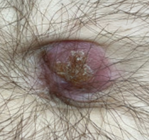Case Presentation: A 47 y/o male with history of known esophageal adenocarcinoma and end-stage renal disease on dialysis presented to the hospital with abdominal pain and melena. The patient was diagnosed with esophageal adenocarcinoma one year prior and has had gastrointestinal bleeding in the recent past. He had an upper endoscopy one month prior which showed a friable and oozing esophageal mass. Unfortunately, he has had poor adherence to outpatient oncology appointments and treatments since time of diagnosis. He returned to the ER with abdominal pain, distension, and two episodes of black stool. He was admitted to the hospital and treated appropriately for acute blood loss anemia and UGI bleeding in the setting of esophageal mass. Physical exam was remarkable for a reddish tender nodule in his umbilicus which was noted to have grown since his previous admission one month earlier. A punch biopsy of the umbilical nodule was performed, and pathology revealed a poorly differentiated adenocarcinoma with morphology and immune profile compatible with metastases of the previously diagnosed esophageal adenocarcinoma.
Discussion: The Sister Mary Joseph nodule is a firm, irregular and small nodule that may be painful, ulcerated, and found protruding from the umbilicus. It represents a metastatic spread of deep-seated gastric/abdominopelvic cancer to the skin (1). The connection between this rare physical exam finding and metastatic abdominopelvic lesions was first published by Dr. William Mayo’s surgical assistant, Sister Mary Joseph in 1928 (2). Differential diagnoses include primary umbilical neoplasm, umbilical and paraumbilical hernia, umbilical endometriosis, keloid, omphalith, pyoderma gangrenosum, and foreign body. A biopsy of the umbilical nodule helps provide a definitive diagnosis of the disease by histological means (3). The most common sources are primary neoplasms from the gastrointestinal and genitourinary tract. The most common sources differ between sexes. In women, primary sites of metastasis are ovarian cancer (37%), endometrial cancer (12%), and rectum, colon, and small bowel (12%). In men, primary sites of metastasis are the stomach (30%), rectum, colon, and small bowel (25%), and pancreas (18%). Patients with this finding typically have an average survival of 11 months and only 13.5% of patients are alive after 2 years (2). Management of a metastatic nodule lies in treating the underlying malignancy.
Conclusions: The Sister Mary Joseph Nodule indicates the metastatic spread of an abdominopelvic neoplastic lesion and generally indicates a poor prognosis. Recognition of this pathologic finding is important as it may warrant more aggressive treatment for existing cancer and alter the goals of care for the patient.

